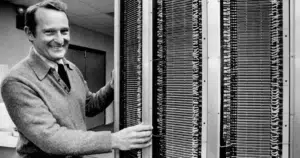Understanding Supercomputers
Supercomputers, first introduced by Control Data Corporation in the 1960s, marked a significant leap in computing power compared to traditional general-purpose computers.
Seymour Cray is credited with developing the first supercomputer, which boasted a higher computational capacity.

Seymour Cray
Initially, supercomputers had limited applications and were not as widely utilized as today.
Unleashing Unrivaled Power
What sets supercomputers apart from household computers is their exceptional processing power and the ability to perform many operations per second. In essence, supercomputers feature advanced GPUs and CPUs.
The computational capability of a supercomputer is measured in FLOPS, or floating-point operations per second.
Presently, the most powerful supercomputers can achieve one hundred quadrillion FLOPS speeds.
Supercomputers as Catalysts
In contemporary times, supercomputers play a pivotal role in driving technological advancements.
One prominent use of supercomputers, perhaps unnoticed by many, is in weather prediction.
Meteorologists rely on supercomputers to process vast amounts of data from various sources worldwide, enabling them to provide increasingly accurate weather forecasts.
Given the extensive data points involved in meteorology, supercomputers are instrumental in global-scale weather prediction.
Supercomputing on the Global Stage
Governments worldwide are investing in developing supercomputers, resulting in a competitive race to create the most advanced supercomputer. In 2017, countries like China, the United States, and the European Union vied to build the first-ever computer capable of processing one quintillion FLOPS.
Supercomputers also contribute significantly to the progress of blockchain-based projects.
Due to their extraordinary computational power, supercomputers are often targeted by hackers. Notably, hackers attempt to compromise supercomputers for cryptocurrency mining purposes.
The immense processing power and enhanced productivity make supercomputers ideal for mining cryptocurrencies.
Pushing the Boundaries
Despite the intense competition for the next groundbreaking development, supercomputers still have room for improvement.
Experts suggest that a supercomputer capable of processing one sextillion FLOPS would be necessary for complete global weather modeling over a two-week period.
However, such technology is yet to be realized.
While there is still progress to be made, supercomputers are already an integral part of our digital advancement.